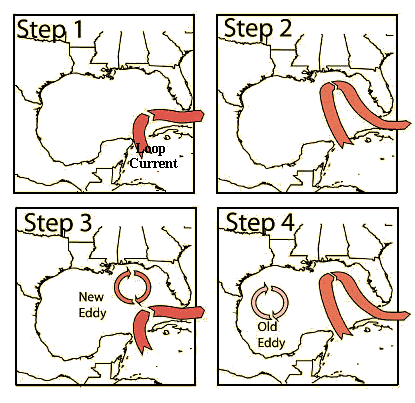By Jeffrey Masters, Ph.D. — Director of Meteorology, Weather Subterranean, Corporation.
The Loop Current is definitely an sea current that transports warm Caribbean water with the Yucatan Funnel between Cuba and Mexico. The present flows northward in to the Gulf, then loops southeastward just south from the Florida Keys (where it’s known as the Florida Current), after which just west from the westernmost Bahamas. Here, the waters from the Loop Current flow northward across the U.S. coast and be the Gulf Stream. With current speeds of approximately .8 m/s, the Loop Current is among the fastest currents within the Atlantic. The present is all about 200 – 300 km (125 – 190 miles) wide, and 800 meters (2600 ft) deep, and it is contained in the Gulf about 95% of times. During summer time and fall, the Loop Current supplies a deep (80 – 150 meter) layer of vary tepid to warm water that may give a huge power source for just about any lucky hurricanes that may mix over.

Figure 1. The Loop Current flow northwards in to the Gulf. Every 6-11 several weeks, a bulge in the present reduces right into a clockwise-rotating eddy that then drifts gradually west-southwestward towards Texas. Image credit: NOAA.
The Loop Current generally bulges in the northern Gulf and often will shed a clockwise rotating ring of tepid to warm water that separates in the primary current (Figure 1). This ring of tepid to warm water gradually drifts west-southwestward towards Texas or Mexico at approximately 3-5 km each day. This selection is known as a "Loop Current Ring", "Loop Current Eddy", or "Warm Core Ring", and may give a key energy source to fuel rapid intensification of hurricanes that mix the Gulf, additionally towards the Loop Current itself. The Loop Current pulsates inside a quasi-regular fashion and sheds rings every 6 to 11 several weeks. Whenever a Loop Current Eddy breaks off within the Gulf in the height of hurricane season, it can result in a harmful situation in which a vast reservoir of one’s can be obtained to the hurricane that may mix over. This happened in 2005, whenever a Loop Current Eddy separated in This summer, right before Hurricane Katrina ignored and "bombed" right into a Category 5 hurricane. The eddy continued to be within the Gulf and gradually drifted westward during September. Hurricane Rita ignored exactly the same Loop Current Eddy three days after Katrina, as well as explosively deepened to some Category 5 storm.
So, a vital question each hurricane months are: when will the following Loop Current Eddy discontinue, developing a ready-made high-octane power source for just about any hurricane that may go by? A great way to answer this would be to read the behavior from the Loop Current in the last year. This is often viewed at Navy Research Lab’s site, together with a large movie (51 Mb) of history year’s currents. This movie has arrows showing the direction of the present, along with a color coding that is representative of the peak from the ocean surface above mean level. The greater the peak, the hotter water (since tepid to warm water expands and therefore enhances the ocean level where it’s at).
We have also saved a duplicate of the animation since the period October 2005-October 2006. It’s possible to see at the outset of the animation the Loop Current Eddy that fueled Katrina and Rita relaxing in the Gulf south of Louisiana. This eddy moves gradually west-southwest to some extent from the Texas coast by November, where it progressively dissipates. A little Loop Current Eddy breaks off eight several weeks later in March, along with a large one just four several weeks later, in This summer. The This summer 2006 eddy will get temporarily re-absorbed in September, then breaks free again by October.
The Navy site provides a 1-month forecast from the Loop Current within the Gulf. However, based on a fascinating Feb 2004 article printed by offshore-engineer.com, reliable forecasts of those currents and eddies aren’t available yet. Bear in mind that currents are impelled by winds, and wind forecasts aren’t reliable out greater than about ten days.
To learn more: A 1998 paper printed within the Journal of Physical Ocenaography entitled, Loop Current Eddy Pathways within the Western Gulf provides some technical info on Loop Eddies. Horizon Marine, Corporation. tracks and forecasts Loop Eddies and offers a pay service with this. Louisiana Condition College includes a nice number of images showing the passages of Ivan, Katrina and Rita over Loop Current Eddies.
Resourse: https://wunderground.com/hurricane/




